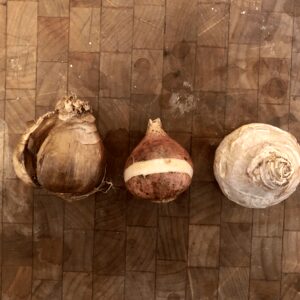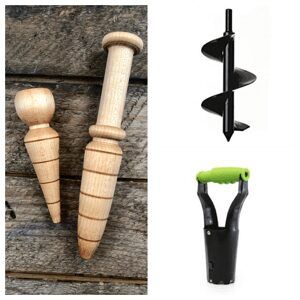Fall and Spring Bulb Planters for Your Garden
Planting bulbs is one of my favorite chores on the farm and in our flower gardens. But ask any gardener “What is the best tool for planting fall and spring bulbs?” and you will get a different answer from everyone you ask. Here are some quick questions to ask before we review each of the tool types:
What Type of Bulbs Are You Planting?
With a large variation of sizes and planting depths, the bulb planting tool you select will likely depend on what flower bulbs you are planting. For instance, a large DN2 18cm Daffodil bulb requires a much larger hole than a small Allium flower bulb. (Read our post on Flower Bulb Sizes). Also, not all tools can work in harder ground, or at deeper bulb planting depths.

What Type of Soil Do You Have?
Your soil type will also help you decide on your garden bulb weapon of choice. If you have prepared a nice raised bed garden with rich, loose soil, you may use a different tool than if you are “roughing” it an digging in native soil to get the naturalized look.
How Is Your Back? 😉
Alright, alright. Let’s get real. For the older ones in the crowd (I am one of them), your back may not be ready for hours of hunching, and you may want to use a tool that allows you to stand up for the digging part.
The Bulb Planter
Ok, so now that we have some of the bulb type, soil and the state of your back :), let’s move on to the different types and their pros and cons:
The Garden Hand Trowel
Back to basics. If you are planting a few flower bulbs, or just digging a trench in which to place your flower bulbs, the old standby trowel will work just fine. Also know as the small shovel, it is a bit old school, but when used correctly will do the job.
Pros of the Trowel for Bulb Planting
- Everyone has one
- Easy to use
- Great for small volume planting
- Good for most soil types
Cons of the Trowel for Planting Bulbs
- Hard on the ol’ back
- Not optimal for large quantities of bulbs
- Can be difficult to use for deep planting
The Bulb Dibbler
The simplest tool a gardener can own has been used for millennia to plant seeds and plants of all types: The garden dibble/dibbler. Essentially a piece of wood to poke holes in the ground, the bulb planting dibbler is made for quick use. Seed dibbles are long and pointy, and bulb dibbles are fat and stout. The bulb dibbler is simple to use and effective.
Pros of the Dibbler for Bulb Planting
- So simple, even a caveman can do it
- Rapid bulb hole making
- Usable for deep and shallow, big and small
- Conveniently marked for easy depth gauging
- Made of all-natural hardwood
Cons of The Dibbler for Bulbs
- Most effective in softer soils
Metal Scoop Planter for Bulbs
These are your typical twist and scoop planter for bulbs. Usually made of metal with a plastic or wood handle, the scoop is angled to try and keep the dirt in and create your hole. I personally don’t like these bulb planters, but many people use them, and its a preference.
Pros of the Metal Bulb Planting Scoop
- Do well in varied soils
- Good for shallow bulb planting
- Make uniform holes
Cons for the Metal Bulb Planter
- Contant twisting to remove dirt
- Dirt gets stuck in clay type soil
- Hard to get deep bulb holes made
- Made of metal and plastic 🙁
The Bulb Auger
The bulb auger planting tool is essentially a drill bit for the garden. Attach the metal or plastic end to a power drill, or if using a manual auger, twist the handle to dig your bulb hole.
Pros of the Bulb Auger Planting Tool
- Stand up version is easy on the back
- Works well in loose soil
- Allows for any depth
Cons of the Bulb Auger
- Hard to gauge depth
- A little messy
- Impossible to dig holes close to each other (Soil fills in bulb holes)
So, that’s a quick view of the bulb planting tool world. You can use them all for any bulb type, and there are enough for any preference in the garden. Go plant some bulbs! You can read our tips for planting bulbs here:











You must be logged in to post a comment.